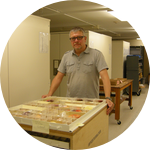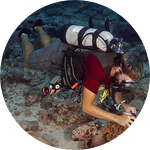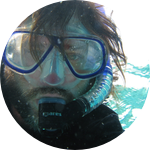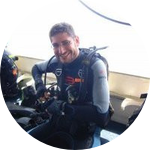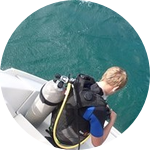Project Results
We are excited to announce that our research has been published in the peer-reviewed journal Marine Ecology Project Series! In this paper, we analyzed seven skeletal features of scleractinian coral colonies that have been historically employed to infer physiological integration. We discovered that highly integrated coral colonies (i.e. colonies whose polyps coordinate with each other in response to injury, predation, disease, and stress) have a lower bleaching response than colonies with more isolated polyps. These findings will assist scientists to identify at-risk coral species and better understand why some species resist bleaching more than others.
Physiological integration of coral colonies is correlated with bleaching resistance
Timothy D. Swain, Emily C. Bold, Phillip C. Osborn, Andrew H. Baird, Mark W. Westneat, Vadim Backman, Luisa A. Marcelino
About This Project
Reef-building corals are bleaching and dying at unprecedented rates due to ocean warming. However, corals bleach at very different rates- why? Corals are association of animals and symbiont algae that feed them. Some corals have skeletons that scatter light back to their algae much faster increasing light availability but that increases their risk of bleaching. We want to identify the skeletal morphological characteristics that may increase the risk of bleaching to better protect coral reefs.
Ask the Scientists
Join The DiscussionWhat is the context of this research?
Corals bleach at different rates. Several factors extrinsic (e.g., environmental) and intrinsic to the coral (e.g., type of symbiont algae or early transcription of key genes) seem to affect the response of the coral to bleaching. Corals are efficient optical machines "growing" algal symbionts which feed them through photosynthesis; skeletal light scattering can increase the light available to the algae. We want to identify the underlying skeletal structures at different scales that are responsible for increasing the light availability to the symbiont algae in the tissue; from the microscopic calcium carbonate grains, to corallites (structures housing the animal), to the whole coral colony.
What is the significance of this project?
Coral bleaching is a response to thermal stress (i.e., increase in ocean temperature). Because high radiation together with high temperature exacerbate the bleaching response, we want to identify the skeletal structures responsible for increasing the light microenvironment of the symbiont algae which would increase stress and precipitate bleaching. Because coral morphology is adapted for light collection, identifying the skeletal structures at different scales that affect light scattering and thus increase the light availability to the Symbiodinium algae will allow us to identify corals at higher risk of bleaching. Light collection has been hypothesized as one of the major evolutionary driving forces in reef-building corals.
What are the goals of the project?
We want to characterize light-scattering in corals and identify the morphological structures that increase light availability to the algae and increase the risk of bleaching. Firstly, we will measure various skeletal features in 100 museum coral skeletons previously characterized in regards to their light scattering and sub-micron morphology. Secondly, we will analyze using imaging, statistical and in particular phylogenetic software packages that correct for evolutionary relatedness of the different corals which may have evolved similar strategies if closely related. Thirdly, we will measure light scattering and morphology at different scales in live corals to predict which corals will be at higher risk of bleaching. In the future, we will bleach these corals to confirm our predictions.
Budget
These funds will allow us to measure various morphological characteristics of 100 coral skeletons which we previously characterized with regards to their light scattering properties at the sub-micron level. We will need access to Enhanced Backscattering spectroscopic equipment to measure morphological characteristics at the sub-micron level (calcium carbonate grains deposited by the coral) and microscopes to measure morphological characteristics at the microscopic level (corallites or the skeletal structures housing each polyp).
We also would like to measure light scattering properties and sub-micromorphology in live corals and in corals collected from specific areas (e.g., a reef slope with increasing depth). We would measure these properties at all scales; from the sub-micron size of calcium carbonate grains to the centimeter size of colony. For that we will need to collect them in the reef and bring them to an aquarium to keep them alive and do the measurements.
Endorsed by
Meet the Team
Affiliates
Team Bio
We are a highly interdisciplinary group of biologists (Luisa Marcelino, Northwestern and Field Museum), ecologists (Tim Swain, Northwestern and Field Museum, Mark Westneat, U of Chicago), optical engineers (Vadim Backman, Northwestern).
Timothy D. Swain
I am an ecologist and molecular phylogeneticist who uses interspecific interactions between marine invertebrates to examine questions of symbiosis evolution, the role of symbiosis in promoting and maintaining biological diversity, and the effects of climate change on symbiotic associations. I use an integrative approach, employing the methods of evolutionary biology, experimental field ecology, molecular phylogenetics, histology, photophysiology, meta-analysis, functional morphology, and systematics as tools to understand the evolution of symbioses. Much of my research focuses on tropical reef corals (Scleractinia), zoanthideans (Zoanthidea), and their associated photosynthetic dinoflagellate (Symbiodinium) symbionts and invertebrate hosts
Check out our lab in the news!
Phillip Osborn
After diving in the Caribbean before my junior year of high school, I fell in love with the natural beauty of coral reef ecosystems. Now a master diver, I have traveled to many locations, including the Bahamas, Mexico and Little Cayman, and I have been blown away by the unique biodiversity at each dive site. During my time at Northwestern, I have been studying why so many corals are bleaching and dying on a monumental scale. Without a concerted human effort, it is very possible that coral reefs could face extinction by the end of the century, and it is my goal to combine my engineering background with my passion for reefs to prevent further reef destruction and rebuild colonies that have already experienced mortality.
Emily Bold
I am an undergraduate student at Northwestern University studying Environmental Science and Biology. I recently spent a semester at the University of Sydney in Sydney, Australia, where I became increasingly aware of the widespread problem of coral bleaching. Following this experience, I hope to incorporate my interests in marine ecology into my future endeavors.
Luisa Marcelino
Additional Information
Ultimately, we will want to understand light transport in both the coral skeleton and the tissue where the symbiont algae are found. This would provide a complete picture of how the tissue scatters and transports sunlight through the coral and how the skeleton scatters and transports sunlight that reaches the skeleton. Currently, a lot is known about light scattering and transport in the tissue, but we are still missing information on the role of the skeleton and tissue in increasing the light availability in the same coral.
Project Backers
- 108Backers
- 112%Funded
- $5,646Total Donations
- $51.80Average Donation


